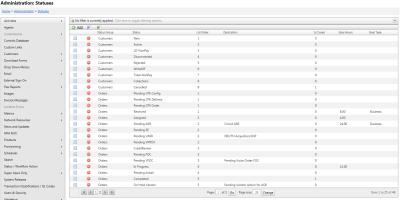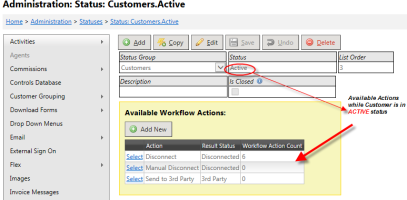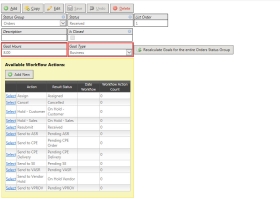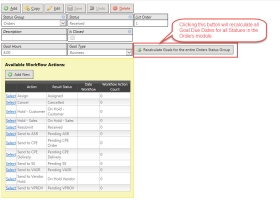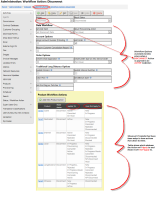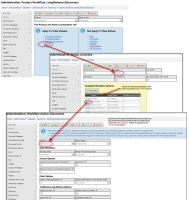Status & Workflow Action Overview
| How do I get here? | Setup / Status & Workflow Action |
| Purpose |
TBS supports what are called a Status /Workflow Actions. This work flow allows items within certain modules of the system to "flow" from status to status by applying certain Actions to the module item. This work flow is completely customizable and controllable by the Status Action settings. This tool ensures that module items follow the client business rules for work flow. Status Action work flow can be managed for the following modules in TBS:
Status Actions support the work flow flow-down to products within certain modules. This is optional depending on client preference. An example might be that applying a disconnect action at the customer level can flow all the way down to all products on the account. In addition, statuses can be flagged to prevent customers from logging in to the system if the customer is in said status. Module items are moved from one Status to another using Actions. The allowable Actions are defined by the Client along with which Result Status should apply to the module item when that Action is selected. View Using Statuses With Actions topic for more information on how to trigger status changes and workflow within TBS. A Few Notes:
|
| Security |
Maintenance Module |
| Taxing Impact | N/A |
| Commission Impact | N/A |
| Data Field Definitions | View Here |
The Status / Workflow Actions administration pages consists of 3 screens:
Statuses
The system supports user defined Statuses for different record types. The "Status Group" indicates the record type (Customers, Orders, Trouble, Products, etc.). On this administration screen, users have a list of all Statuses, can filter by any field on the grid and can select or add new records.
Selecting an option from the Status Group list allows the user to define the "Workflow Actions" that are available from each status.
Users can drill in further by clicking the Select next to the corresponding Workflow Action they wish to view/edit. This will take the user to the Workflow Actions screen described in the next section.
Orders SLA / Goal Tracking
In an effort to support, track and monitor service level agreement goals within the Orders module, the system supports the ability to define SLA Goals for each of the Order Status Groups. These fields allow better insight and tracking into the turnaround times within each Order status, help prioritize open Orders as well as help identify bottlenecks as items are passed through the workflow statuses.
Order Group statuses can have a Goal defined for each status (in hours) which determines the amount of hours an Order should be in a specific status before moving on to the next. For example, an Orders Received status may have a Goal of 8 hours. In addition to defining the Goal/Hours for the status, clients must also define the Goal Type as being either Business days or Calendar days.
NOTE: Business hours are defined as 9:00 AM to 5:00 PM, Monday - Friday where Calendar days are 24 hour increments 7 days per week.
For our example, if the Orders "Received" status has a Goal of 8 and a Goal Type of "Business", then the Order should be moved along to a new status within 8 business hours of being set to Received. If the Order has not changed statuses by this time frame, the Order is considered behind.
The combination of these two fields will calculate the Goal Due Date of the Order based on the current status which appears on the Order Processing screen as well as within the Order Inventory grid.
Once the Goal Hours and Goal Type are set on an Order's status, Goals for the entire Order Status Group can be updated using a recalculate button. In addition, any time a status changes on an Order, the Goal Due Date is recalculated / updated.
Workflow Actions
These actions can be performed by a user when a record is in a particular status. Users define the desired behavior for each Workflow action. These behaviors consist of:
- Setting a Resulting Status
- Setting a Resulting Provisioning Action (Traditional LD Only)
- Setting / Clearing either the Active Date, Disconnect Date or both
- Setting Account Options
- Setting Order Options
- Setting Long Distance Options (Traditional LD Only)
This screen has informational labels ![]() that more clearly define these behaviors. Fields are not Editable if an option is not applicable to the current Status Group.
that more clearly define these behaviors. Fields are not Editable if an option is not applicable to the current Status Group.
Users can view/edit further into the details of the Product Workflow actions by clicking the Select link next to the corresponding Product Workflow Action.
Product Workflow Actions
The Product Actions are only available on Customers and Orders Status Group. These define the Workflow Actions (2 above) that "flow down" to the Products associated with the current Customer or Order.
When selecting a Product Workflow Action, the system will display the Product Statuses to which this Workflow Action Will Apply and will NOT apply. Users can view/edit the behavior that will occur when applying the Action to an item in a certain status by clicking the link for the status in question. This will take the user to the Workflow Actions screen for that particular Action. Example below is for Long Distance Active status when applying a Disconnect Action.
You can also clear a surcharge on a voice product when a specific workflow action is performed using the new Clear Surcharge check box.
Status Key Fields / Terms
| Field | Description | Notes |
|---|---|---|
| Status Group |
Module name the status belongs to. These are predefined by TBS. Options include:
|
|
| Status | Status name | |
| List Order | Numerical placement of where the status should appear in the selection drop downs | |
| Description | Optional description - informational only | |
| Is Closed |
Used with Orders and LD (Traditional) statuses. If checked, this indicates that this status may represent the last step in a status work flow process. This flag is considered when Closing out Orders and also will prevent future edits to be made to the Order once it reaches an Order status where isClosed=True. |
|
| Set Active Status From CDR |
0 = Do nothing 1 = Set the status of the product to Active if there are CDRs present 2= Report that there are CDRs present for products in this status |
Only available with the Customers Status Group |
| Prevent Login | If set, customers in this status will not be able to login. | Only available with the Customers Status Group |
| First CDR Action |
Specify a workflow action to run on a product the first time that a Call Detail Record (CDR) is received. |
If any errors are encountered, a notification appears, providing a link to a separate screen that displays the errors in detail. Once any issues are fixed, the action is attempted again the following day. Only available with the Products Status Group |
| Report CDRs past Disconnect Date | When selected, products in a certain status that are still receiving CDRs after a disconnect date are reported. |
Example: For the product status of Disconnected, you have selected (checked) this option. A product called 301-555-1234 is in the Disconnected status (with a disconnect date of 10/1/2018) and CDRs are received on 10/5/2018. A notification appears, providing a link to a screen listing the errors. However, the carrier is contacted and there was a problem with the disconnect order, and the problem has been fixed. To signify that you're no longer concerned with the CDRs on 10/5/2018, you can selected (check) this option for the product (301-555-1234). The existing issue is deleted, and the next time this process runs, it will only look for CDRs later than 10/5/2018. Only available with the Products Status Group |
| Goal Hours |
Used within the Orders Module Only: The maximum number of hours an Order should remain in this status (to support Service Level Agreements). |
This number combined with the Goal Type drives SLA (Goal Due) indicators on the Order Inventory grid and Orders Tree. |
| Goal Type | Corresponds with Goal Hours for calculating the "Goal Due" on an Order. Business Hours are M-F 9-5, Calendar Hours are 24X7. |
This type combined with the Goal Hours drive SLA (Goal Due) indicators on the Order Inventory grid and Orders Tree. |
